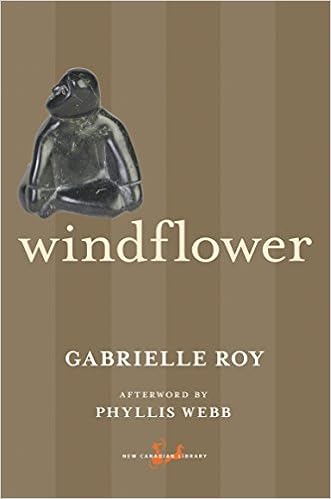I was introduced to Gabrielle Roy in high school when I read Rue Deschambault in French class; later in a Canadian literature class in university I read The Tin Flute and Where Rests the Water Hen. Recently, I was browsing through my bookshelves and came across Windflower which I realized I had not read. I decided to do so.
This short novel focuses on Elsa Kumachuk, an Inuit woman living in
northern Quebec in the middle of the 20th century. She is raped by an American serviceman
stationed in the area and gives birth to a blond-haired, blue-eyed boy whom she
names Jimmy. Because of her son’s dual
heritage, Elsa is torn between raising her son according to traditional Inuit ways
and the ways of the whites.
The novel was published in 1970, and it is a bit dated. Elsa and her people are called Eskimos rather
than Inuit and what is called Fort Chimo is now known as Kuujjuaq. In its portrayal of motherhood and a society
in transition however, the book is timeless.
The Inuit "with their indulgent natures" have a very easygoing parenting style, letting the child explore
the world, as evidenced when Jimmy starts to walk. Having adopted the parenting style she sees
at the home of Madame Beaulieu, Elsa buys a playpen to restrict Jimmy’s
movements. Elsa’s family is aghast: “Never before had such an interference with liberty been seen in an Eskimo
family. . . . it was not right to
restrict a little child who had just discovered the delight of being able to
take himself wherever he wanted to go on his own two feet.” Elsa dresses her son only in blue and gives him
a bath at the exact same time every day:
“From the white men, it seemed to her, she had learned much that was
excellent – for instance to get up early, to rush all day scarcely ever
dawdling any more, to take up tasks by the clock and not by the inclination of
the moment.”
Later, Elsa decides to entirely remove herself and Jimmy from the
community with its “endless increase of constraints.” She moves across the river to live with her
uncle who has self-isolated and lives a traditional Inuit life; in fact, he
considers anyone who lives in Fort Chimo as “’a slave living in captivity.’” Unfortunately,
though both Jimmy and Elsa are happier living simply, the laws of the white man
curtail their freedom.
The idea
of being held captive by materialism is emphasized. The pastor warns Elsa that “one could not
have everything one wanted in this life and freedom too” because he fears that
she has “’embarked on that endless road of never quite enough possessions.’” When she gets the luxury of electricity, it
means she feels compelled to work “far into the evening.” Eventually she agrees with the pastor: “the less one owned the better. Her princely hut and the luxury in which she
had lived now seemed to her shackles.”
From the
beginning, the reader knows that the book will not have a happy ending. Elsa’s love for her child is unquestionable
but, like her mother, Elsa is caught “between the cruel blades of the
times: what to change, what to keep?” Despite its pervasive sadness, this is a
worthwhile read.

No comments:
Post a Comment